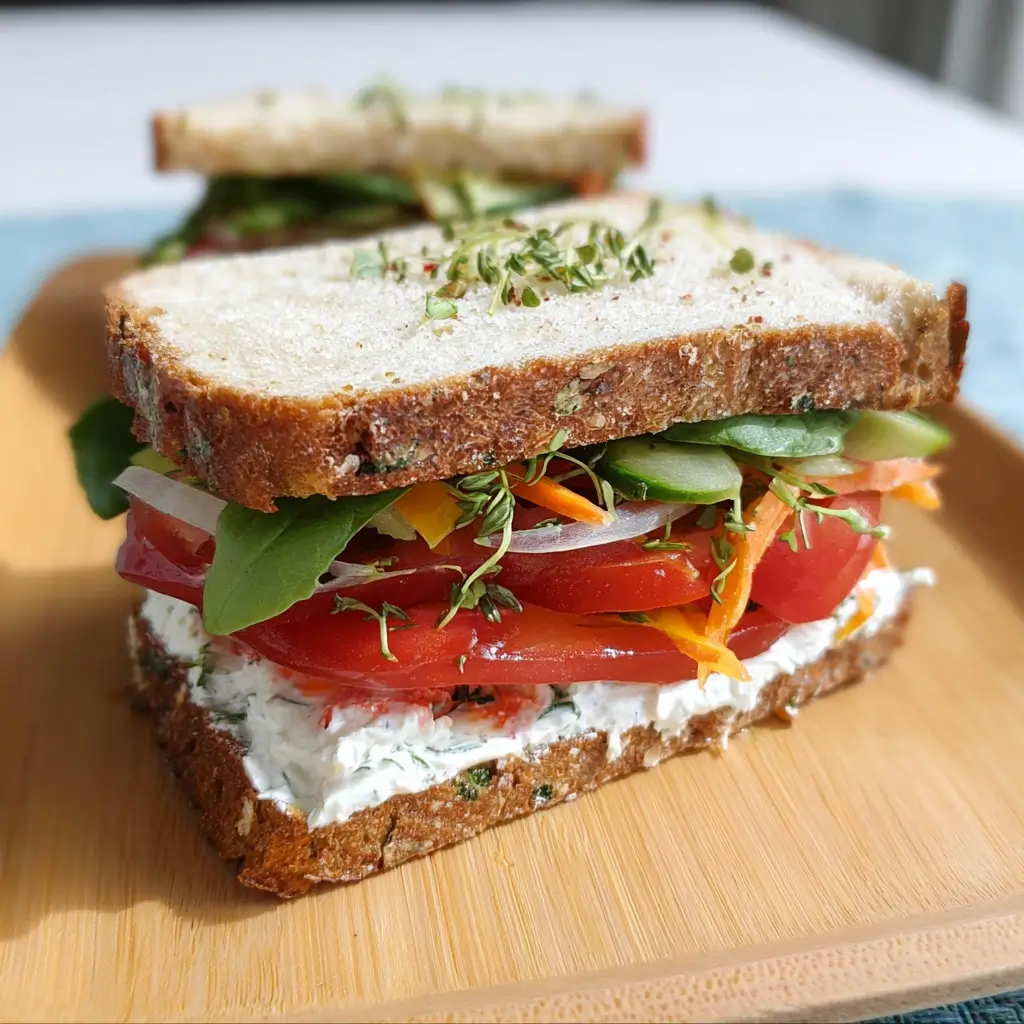Of all the simple pleasures in life, a truly great sandwich ranks near the top for me. I’m not talking about a hastily thrown-together affair, but a deliberate, thoughtful creation where every layer serves a purpose. This Veggie Sandwich with Herbed Cream Cheese is exactly that—a masterpiece of simplicity. I remember the first time I made it for a weekend family lunch. The kids, who usually push vegetables around their plates, were completely silent, focused only on the symphony of crunches and the creamy, tangy spread. My husband, a self-proclaimed carnivore, raised an eyebrow in surprise and declared it “restaurant-quality.” Since then, it has become our go-to recipe for everything from busy weekday lunches and lazy Sunday brunches to a star player in our picnic baskets. It’s the kind of meal that feels both incredibly wholesome and delightfully indulgent. The magic lies in the homemade herbed cream cheese; it’s a game-changer that elevates a humble veggie sandwich into something truly special, coating every bite with a fresh, aromatic flavor that perfectly complements the crisp, vibrant vegetables. This isn’t just a recipe; it’s a celebration of fresh ingredients and the joy of a perfectly constructed bite.
The Ultimate Veggie Sandwich: A Symphony of Crunch and Creaminess
This recipe is designed to be a blueprint for perfection. While the ingredients are simple, the way they come together creates a complex and satisfying flavor profile. The star of the show is the herbed cream cheese, which acts as both a flavorful spread and a crucial moisture barrier, ensuring your sandwich stays crisp and delicious. Paired with a rainbow of fresh, crunchy vegetables and hearty, rustic bread, this sandwich is a testament to the fact that vegetarian meals can be incredibly hearty and fulfilling.
Ingredients for the Perfect Veggie Sandwich
To ensure the best possible result, we’ve broken down the ingredients into two components: the all-important herbed cream cheese and the sandwich assembly itself. Using high-quality, fresh ingredients will make a world of difference.
For the Herbed Cream Cheese Spread (Yields approx. 1 cup)
- Cream Cheese: 1 block (8 ounces / 226g), full-fat, softened to room temperature. Using full-fat cream cheese provides the best flavor and a richer, creamier texture. Softening it is crucial for a smooth, lump-free spread.
- Fresh Dill: 2 tablespoons, finely chopped. Dill brings a slightly tangy, grassy flavor that is classic in cream cheese spreads.
- Fresh Chives: 2 tablespoons, finely chopped. Chives add a delicate, mild onion flavor that isn’t overpowering.
- Fresh Parsley: 1 tablespoon, flat-leaf or curly, finely chopped. Parsley adds a fresh, clean, and slightly peppery note.
- Garlic Powder: ½ teaspoon. This provides a gentle, savory garlic undertone without the sharp bite of fresh garlic.
- Onion Powder: ¼ teaspoon. This adds a deeper, savory base note that complements the chives.
- Lemon Juice: 1 teaspoon, freshly squeezed. The acidity from the lemon juice brightens up all the flavors and cuts through the richness of the cream cheese.
- Fine Sea Salt: ¼ teaspoon, or to taste.
- Freshly Ground Black Pepper: ¼ teaspoon, or to taste.
For the Sandwich Assembly (Makes 4 sandwiches)
- Bread: 8 slices of your favorite high-quality bread. Sourdough, whole wheat, multigrain, ciabatta, or a rustic farmhouse loaf are all excellent choices. The bread should be sturdy enough to hold the fillings.
- Cucumber: 1 medium, thinly sliced into rounds. English or Persian cucumbers are great as they have fewer seeds and thinner skin.
- Bell Pepper: 1 medium, any color (red, yellow, or orange for sweetness), thinly sliced.
- Red Onion: ¼ of a large onion, very thinly sliced. Soaking the slices in cold water for 10 minutes can mellow their sharp bite.
- Tomatoes: 2 medium ripe Roma or vine-ripened tomatoes, thinly sliced. Roma tomatoes are a good choice as they tend to be less watery.
- Lettuce or Greens: 2 cups of crisp lettuce (like romaine or butter lettuce) or other greens like baby spinach or arugula.
- Alfalfa or Broccoli Sprouts: 1 cup, for added texture and a fresh, earthy flavor.
Step-by-Step Instructions: Crafting Your Masterpiece
Follow these detailed instructions to build your sandwich from the ground up, ensuring every element is perfectly prepared for the final, delicious assembly.
Part 1: Whipping Up the Herbed Cream Cheese
This spread is the heart and soul of the sandwich. Making it correctly sets the stage for success.
- Prepare the Cream Cheese: Ensure your cream cheese is fully softened to room temperature. This is the most important step for achieving a silky-smooth consistency. If you’re short on time, you can unwrap the block of cream cheese, place it on a microwave-safe plate, and microwave it in 10-second intervals until just softened, but not melted.
- Combine Ingredients: In a medium-sized bowl, place the softened cream cheese. Add the finely chopped dill, chives, and parsley. Sprinkle in the garlic powder, onion powder, salt, and pepper.
- Mix Thoroughly: Using a flexible spatula, begin to fold and mix the herbs and seasonings into the cream cheese. Scrape the sides and bottom of the bowl frequently to ensure everything is evenly incorporated. For an even lighter, whipped texture, you can use an electric hand mixer on a low speed.
- Add Lemon Juice: Drizzle the fresh lemon juice over the mixture. Continue to mix until it is fully combined. The lemon juice will slightly thin the mixture and make it even more spreadable while brightening the overall flavor.
- Taste and Adjust: Give the herbed cream cheese a taste. Adjust the seasoning if necessary—you might prefer a bit more salt, a stronger herby flavor, or another squeeze of lemon.
- Set Aside: Cover the bowl and set the cream cheese aside while you prepare the rest of your ingredients. This also gives the flavors a moment to meld together.
Part 2: Assembling the Ultimate Veggie Sandwich
The art of sandwich assembly is all about strategic layering to maximize flavor and prevent sogginess.
- Prepare the Vegetables: Wash and thoroughly dry all your vegetables. This is key to preventing a watery sandwich. Slice the cucumber, bell pepper, red onion, and tomatoes as thinly and uniformly as possible. A mandoline slicer can be very helpful for this, but a sharp knife will also work well.
- Toast the Bread (Optional but Recommended): Lay your 8 slices of bread on a baking sheet and toast them lightly in an oven, toaster, or on a grill pan. Toasting the bread not only adds a wonderful flavor and texture but also creates a firm surface that stands up better to the creamy spread and moist vegetables.
- Apply the Foundation: Lay the bread slices out on a clean work surface or cutting board. Using a butter knife or offset spatula, slather a thick, generous layer of the prepared herbed cream cheese on one side of each of the 8 slices of bread. Be sure to spread it all the way to the edges. This cream cheese layer acts as a delicious, waterproof barrier between the bread and the veggies.
- Layer the Greens: On four of the bread slices (these will be your bottom slices), place a layer of your chosen greens, such as romaine lettuce or baby spinach. The greens create another protective layer and prevent the more watery vegetables from direct contact with the bread.
- Build the Veggie Stack: Now, begin layering your prepared vegetables on top of the greens. There’s no single right way to do this, but a good method is to layer in this order for stability and flavor distribution:
- Thinly sliced tomatoes
- Thinly sliced cucumber
- Thinly sliced bell pepper
- Very thinly sliced red onion
- Add the Finishing Touch: Top the stack of vegetables with a generous handful of alfalfa or broccoli sprouts. The sprouts add a fantastic, delicate crunch and a fresh, slightly nutty flavor that ties everything together.
- Close and Press: Place the remaining four cream cheese-slathered bread slices on top of the sprouts, spread-side down. Gently press down on the top of each sandwich with the palm of your hand. This helps to compact the layers slightly and makes the sandwich easier to handle and eat.
- Slice and Serve: For a professional-looking presentation and easier eating, use a sharp serrated bread knife to slice the sandwiches in half on the diagonal. The serrated edge will cut through the layers cleanly without squishing the contents. Secure with a sandwich pick if desired, and serve immediately.
Nutritional Information: A Healthy and Hearty Choice
This sandwich is packed with vitamins and fiber from the fresh vegetables, making it a nutritious and satisfying meal.
- Servings: This recipe makes 4 complete sandwiches.
- Calories Per Serving: Approximately 480-550 calories per sandwich.
Disclaimer: The nutritional information provided is an estimate and can vary significantly based on the specific type of bread, the fat content of the cream cheese, and the exact quantity of vegetables used.
Preparation Time: Quick and Effortless
This recipe is perfect for a quick lunch or a light dinner, as it comes together in under half an hour.
- Preparation Time: 15 minutes (for chopping vegetables and mixing the cream cheese)
- Assembly Time: 5 minutes
- Total Time: 20 minutes
How to Serve Your Veggie Sandwich with Herbed Cream Cheese
While this sandwich is a star on its own, it pairs wonderfully with a variety of sides to create a more substantial and complete meal.
- Classic Soup and Sandwich Combo:
- Pair it with a bowl of warm, comforting soup. A creamy Tomato Basil Soup is a classic choice, as its acidity and sweetness perfectly complement the creamy, herby sandwich. A light Potato Leek Soup or a vibrant Spring Pea and Mint Soup would also be fantastic partners.
- With a Crisp Side Salad:
- Double down on the freshness by serving the sandwich with a simple side salad. A light vinaigrette-dressed mixed green salad, a zesty Quinoa Tabbouleh, or a tangy Coleslaw would add another layer of texture and flavor.
- For the Perfect Picnic Basket:
- These sandwiches are ideal for picnics because they hold up relatively well. Wrap each sandwich tightly in parchment paper or beeswax wrap. Pack them alongside a bag of sea salt potato chips, some whole fruit (like apples or grapes), and a thermos of iced tea or lemonade for a perfect outdoor meal.
- Kid-Friendly Presentation:
- Make lunch fun for kids by using cookie cutters to cut the sandwiches into interesting shapes like stars, hearts, or dinosaurs. Serve with a side of baby carrots, apple slices, and a small yogurt for a balanced and appealing meal.
- As Part of a Brunch Spread:
- Cut the sandwiches into smaller, four-bite triangles (or “finger sandwiches”) and arrange them on a platter. They make a wonderful addition to a brunch menu alongside items like a fruit salad, quiche, and pastries.
Additional Tips for Sandwich Perfection
Take your veggie sandwich from great to absolutely unforgettable with these five expert tips.
- Toast Your Bread for a Superior Crunch: We mentioned it in the instructions, but it bears repeating. Toasting your bread is non-negotiable for a premium sandwich experience. It does more than just add a golden color; it creates a textural contrast to the soft filling and, most importantly, reinforces the bread, preventing it from becoming a soggy mess from the vegetable moisture.
- The Art of Vegetable Preparation: The key to a non-watery veggie sandwich lies in how you prep your vegetables. After washing, pat them thoroughly dry with a paper towel. For vegetables with high water content like tomatoes and cucumbers, you can even lightly salt them, let them sit for a few minutes to draw out excess water, and then pat them dry again before adding them to the sandwich. Slicing everything thinly ensures the sandwich is easy to eat and not overly bulky.
- Make the Herbed Cream Cheese Ahead of Time: The herbed cream cheese spread actually tastes even better when made a day or two in advance. This gives the flavors of the fresh herbs, garlic, and lemon a chance to fully infuse into the cream cheese. Store it in an airtight container in the refrigerator for up to 5 days. This makes assembly on a busy day even faster!
- Don’t Skimp on the Spread: Be generous when you apply the herbed cream cheese. A thick layer does two things: it ensures you get a burst of creamy, herby flavor in every single bite, and it fortifies the moisture barrier between the bread and the fillings. Spreading it from crust to crust is a pro move to seal the entire surface of the bread.
- Experiment with Delicious Add-ins: Think of this recipe as a fantastic base for your creativity. Elevate your sandwich with extra layers of flavor and texture.
- Add Avocado: Sliced or mashed avocado adds a wonderful buttery richness.
- Introduce a Second Spread: A thin layer of hummus or pesto on the other slice of bread can add a new dimension of flavor.
- Incorporate Pickled Elements: A few pickled red onions or banana peppers can add a zesty, acidic kick that cuts through the richness of the cream cheese.
- Add a Different Cheese: A slice of provolone, Swiss, or Havarti can add a nutty, salty element.
Frequently Asked Questions (FAQ)
Here are answers to some common questions you might have about making this delicious veggie sandwich.
1. How do I prevent my veggie sandwich from getting soggy if I’m packing it for lunch?
This is the most common sandwich challenge! The best strategy is a multi-pronged defense. First, toast the bread. Second, use the herbed cream cheese as a sealant on both slices, spreading it to every edge. Third, pat all your vegetables completely dry. Finally, layer strategically: place durable greens like romaine or spinach directly against the cream cheese, and place watery vegetables like tomatoes in the middle, cushioned by other ingredients. If packing for several hours later, consider packing the veggies and the cream-cheesed bread separately and assembling just before eating.
2. Can I make this veggie sandwich vegan?
Absolutely! This recipe is very easy to adapt for a vegan diet. Simply swap the regular cream cheese for your favorite brand of plain, unsweetened vegan cream cheese. Most high-quality nut-based (cashew or almond) or tofu-based cream cheeses will work beautifully. Also, ensure the bread you choose is vegan, as some varieties can contain honey, eggs, or dairy.
3. What is the best type of bread to use for this sandwich?
The “best” bread often comes down to personal preference, but sturdiness is key.
- Sourdough: Offers a wonderful tangy flavor that complements the cream cheese and has a robust crust.
- Whole Wheat or Multigrain: Provides a nutty, wholesome flavor and extra fiber. Look for a rustic loaf with a good structure.
- Ciabatta or Focaccia: These Italian breads have an open, airy crumb but are sturdy enough to hold up to fillings, making them excellent choices.
- Rye Bread: The earthy, slightly sour flavor of rye is a fantastic match for the dill and chives in the cream cheese.
4. How long can I store the assembled sandwich in the refrigerator?
For the absolute best taste and texture, this sandwich is best enjoyed fresh. However, if you need to make it ahead, you can assemble it, wrap it very tightly in plastic wrap or parchment paper, and store it in the refrigerator for up to 4-6 hours. Any longer, and even with precautions, the bread will begin to soften. The herbed cream cheese itself can be stored in an airtight container in the fridge for up to 5 days.
5. Can I use dried herbs instead of fresh herbs for the cream cheese?
Yes, you can use dried herbs if fresh ones are unavailable, but the flavor will be different and less vibrant. The general rule of thumb for conversion is 1 teaspoon of dried herbs for every 1 tablespoon of fresh herbs. So, for this recipe, you would use approximately ⅔ tablespoon of dried dill, ⅔ tablespoon of dried chives, and 1 teaspoon of dried parsley. Allow the cream cheese to sit for at least 30 minutes after mixing to give the dried herbs time to rehydrate and release their flavor. Fresh herbs are highly recommended for the best result.
Print
Veggie Sandwich with Herbed Cream Cheese Recipe
Ingredients
For the Herbed Cream Cheese Spread (Yields approx. 1 cup)
- Cream Cheese: 1 block (8 ounces / 226g), full-fat, softened to room temperature. Using full-fat cream cheese provides the best flavor and a richer, creamier texture. Softening it is crucial for a smooth, lump-free spread.
- Fresh Dill: 2 tablespoons, finely chopped. Dill brings a slightly tangy, grassy flavor that is classic in cream cheese spreads.
- Fresh Chives: 2 tablespoons, finely chopped. Chives add a delicate, mild onion flavor that isn’t overpowering.
- Fresh Parsley: 1 tablespoon, flat-leaf or curly, finely chopped. Parsley adds a fresh, clean, and slightly peppery note.
- Garlic Powder: ½ teaspoon. This provides a gentle, savory garlic undertone without the sharp bite of fresh garlic.
- Onion Powder: ¼ teaspoon. This adds a deeper, savory base note that complements the chives.
- Lemon Juice: 1 teaspoon, freshly squeezed. The acidity from the lemon juice brightens up all the flavors and cuts through the richness of the cream cheese.
- Fine Sea Salt: ¼ teaspoon, or to taste.
- Freshly Ground Black Pepper: ¼ teaspoon, or to taste.
For the Sandwich Assembly (Makes 4 sandwiches)
- Bread: 8 slices of your favorite high-quality bread. Sourdough, whole wheat, multigrain, ciabatta, or a rustic farmhouse loaf are all excellent choices. The bread should be sturdy enough to hold the fillings.
- Cucumber: 1 medium, thinly sliced into rounds. English or Persian cucumbers are great as they have fewer seeds and thinner skin.
- Bell Pepper: 1 medium, any color (red, yellow, or orange for sweetness), thinly sliced.
- Red Onion: ¼ of a large onion, very thinly sliced. Soaking the slices in cold water for 10 minutes can mellow their sharp bite.
- Tomatoes: 2 medium ripe Roma or vine-ripened tomatoes, thinly sliced. Roma tomatoes are a good choice as they tend to be less watery.
- Lettuce or Greens: 2 cups of crisp lettuce (like romaine or butter lettuce) or other greens like baby spinach or arugula.
- Alfalfa or Broccoli Sprouts: 1 cup, for added texture and a fresh, earthy flavor.
Instructions
Part 1: Whipping Up the Herbed Cream Cheese
This spread is the heart and soul of the sandwich. Making it correctly sets the stage for success.
- Prepare the Cream Cheese: Ensure your cream cheese is fully softened to room temperature. This is the most important step for achieving a silky-smooth consistency. If you’re short on time, you can unwrap the block of cream cheese, place it on a microwave-safe plate, and microwave it in 10-second intervals until just softened, but not melted.
- Combine Ingredients: In a medium-sized bowl, place the softened cream cheese. Add the finely chopped dill, chives, and parsley. Sprinkle in the garlic powder, onion powder, salt, and pepper.
- Mix Thoroughly: Using a flexible spatula, begin to fold and mix the herbs and seasonings into the cream cheese. Scrape the sides and bottom of the bowl frequently to ensure everything is evenly incorporated. For an even lighter, whipped texture, you can use an electric hand mixer on a low speed.
- Add Lemon Juice: Drizzle the fresh lemon juice over the mixture. Continue to mix until it is fully combined. The lemon juice will slightly thin the mixture and make it even more spreadable while brightening the overall flavor.
- Taste and Adjust: Give the herbed cream cheese a taste. Adjust the seasoning if necessary—you might prefer a bit more salt, a stronger herby flavor, or another squeeze of lemon.
- Set Aside: Cover the bowl and set the cream cheese aside while you prepare the rest of your ingredients. This also gives the flavors a moment to meld together.
Part 2: Assembling the Ultimate Veggie Sandwich
The art of sandwich assembly is all about strategic layering to maximize flavor and prevent sogginess.
- Prepare the Vegetables: Wash and thoroughly dry all your vegetables. This is key to preventing a watery sandwich. Slice the cucumber, bell pepper, red onion, and tomatoes as thinly and uniformly as possible. A mandoline slicer can be very helpful for this, but a sharp knife will also work well.
- Toast the Bread (Optional but Recommended): Lay your 8 slices of bread on a baking sheet and toast them lightly in an oven, toaster, or on a grill pan. Toasting the bread not only adds a wonderful flavor and texture but also creates a firm surface that stands up better to the creamy spread and moist vegetables.
- Apply the Foundation: Lay the bread slices out on a clean work surface or cutting board. Using a butter knife or offset spatula, slather a thick, generous layer of the prepared herbed cream cheese on one side of each of the 8 slices of bread. Be sure to spread it all the way to the edges. This cream cheese layer acts as a delicious, waterproof barrier between the bread and the veggies.
- Layer the Greens: On four of the bread slices (these will be your bottom slices), place a layer of your chosen greens, such as romaine lettuce or baby spinach. The greens create another protective layer and prevent the more watery vegetables from direct contact with the bread.
- Build the Veggie Stack: Now, begin layering your prepared vegetables on top of the greens. There’s no single right way to do this, but a good method is to layer in this order for stability and flavor distribution:
- Thinly sliced tomatoes
- Thinly sliced cucumber
- Thinly sliced bell pepper
- Very thinly sliced red onion
- Add the Finishing Touch: Top the stack of vegetables with a generous handful of alfalfa or broccoli sprouts. The sprouts add a fantastic, delicate crunch and a fresh, slightly nutty flavor that ties everything together.
- Close and Press: Place the remaining four cream cheese-slathered bread slices on top of the sprouts, spread-side down. Gently press down on the top of each sandwich with the palm of your hand. This helps to compact the layers slightly and makes the sandwich easier to handle and eat.
- Slice and Serve: For a professional-looking presentation and easier eating, use a sharp serrated bread knife to slice the sandwiches in half on the diagonal. The serrated edge will cut through the layers cleanly without squishing the contents. Secure with a sandwich pick if desired, and serve immediately.
Nutrition
- Serving Size: One Normal Portion
- Calories: 480-550





